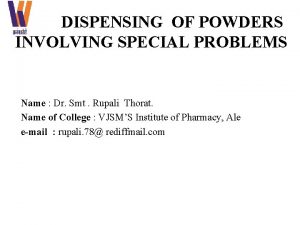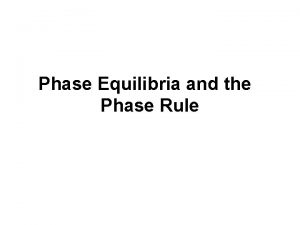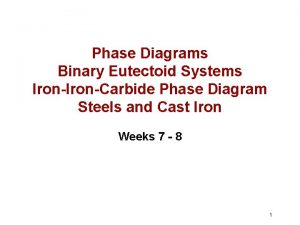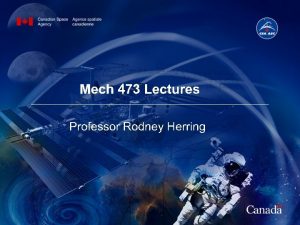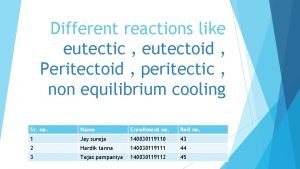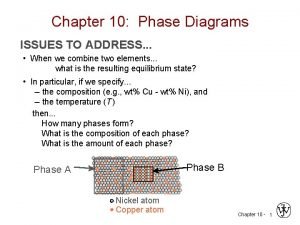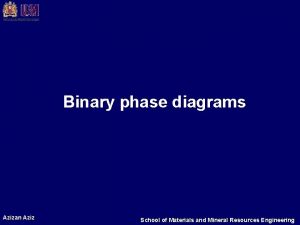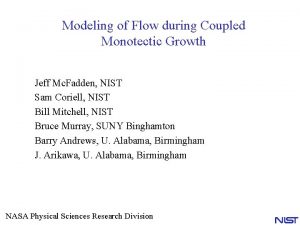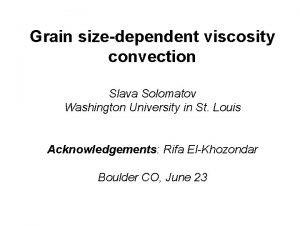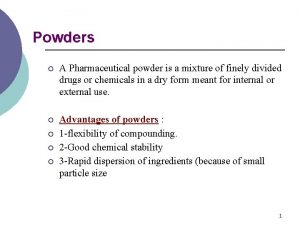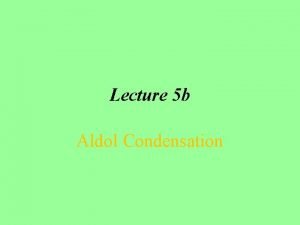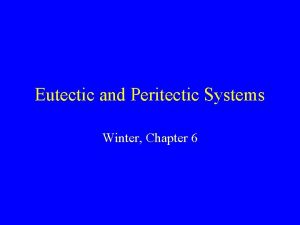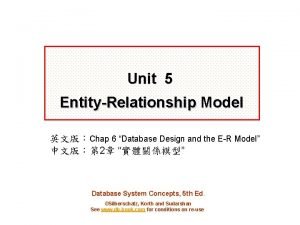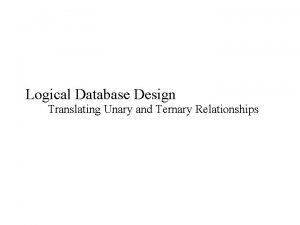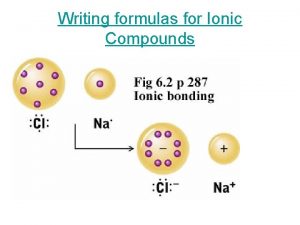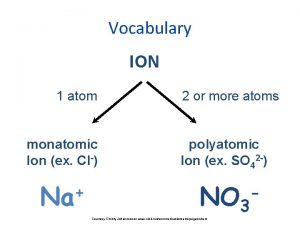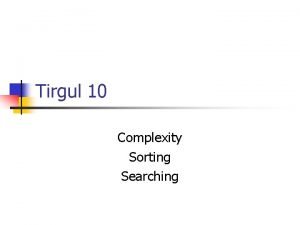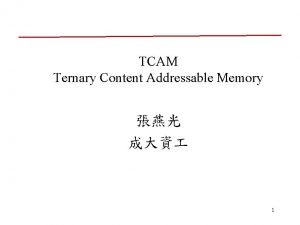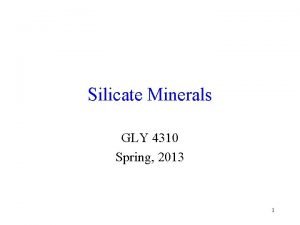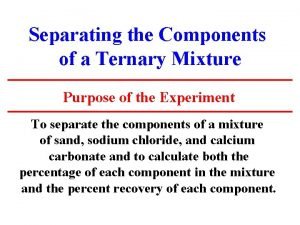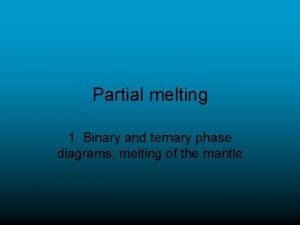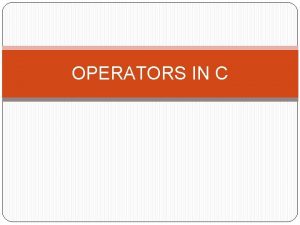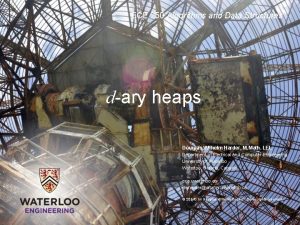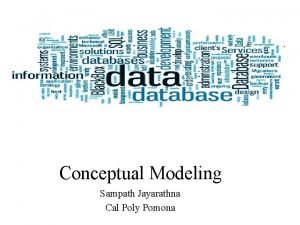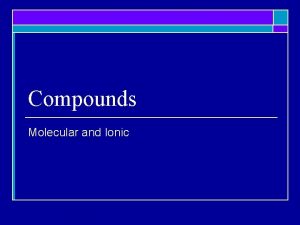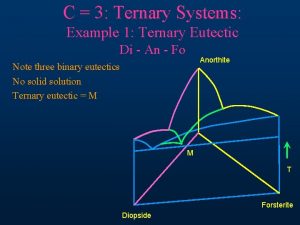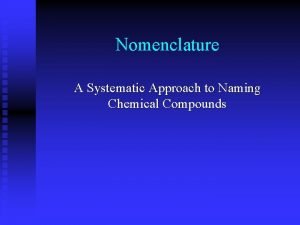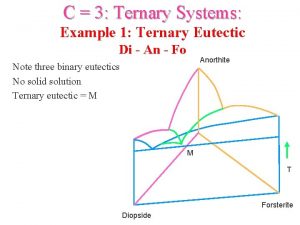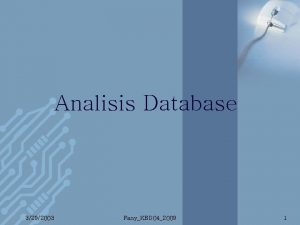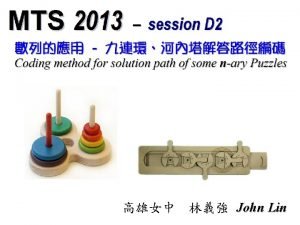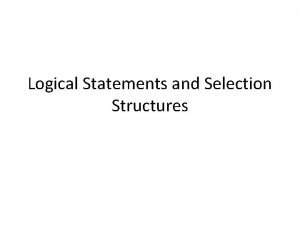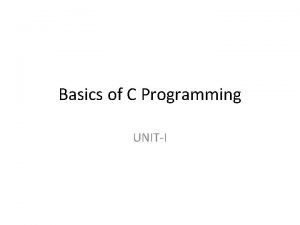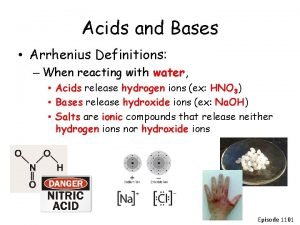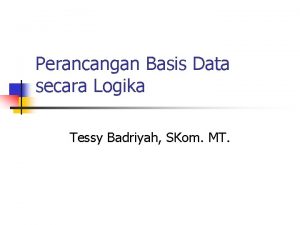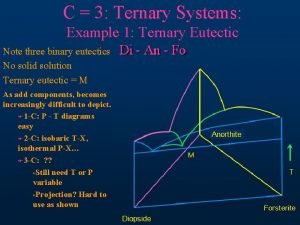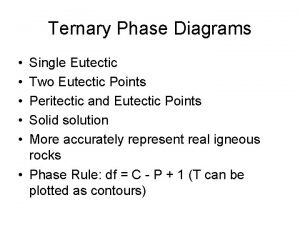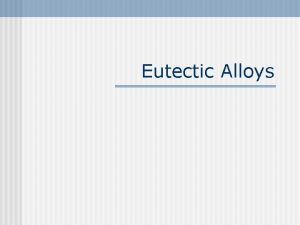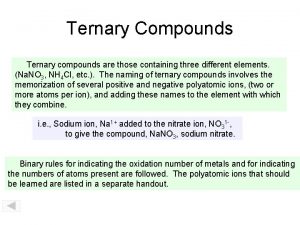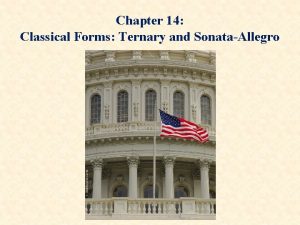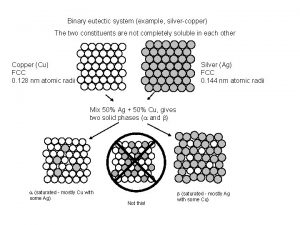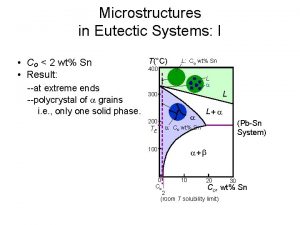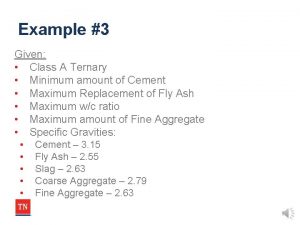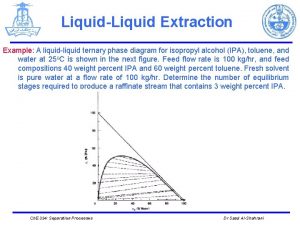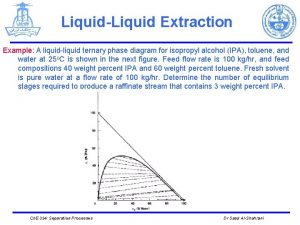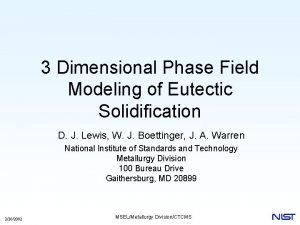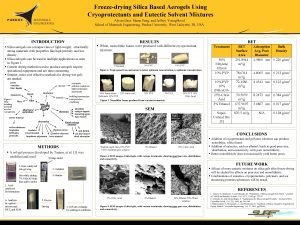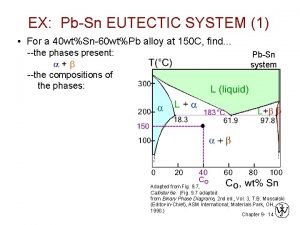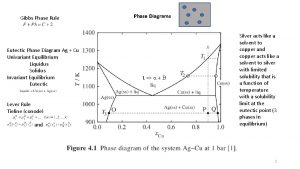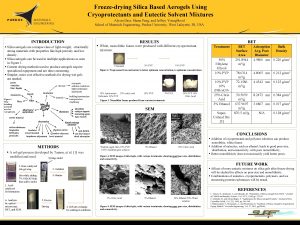C 3 Ternary Systems Example 1 Ternary Eutectic



















































- Slides: 51

C = 3: Ternary Systems: Example 1: Ternary Eutectic Di - An - Fo Anorthite Note three binary eutectics No solid solution Ternary eutectic = M M T Forsterite Diopside

T - X Projection of Di - An - Fo Figure 7 -2. Isobaric diagram illustrating the liquidus temperatures in the Di-An-Fo system at atmospheric pressure (0. 1 MPa). After Bowen (1915), A. J. Sci. , and Morse (1994), Basalts and Phase Diagrams. Krieger Publishers.

Crystallization Relationships

Liquid a An + Liq Di + An Pure Fo forms Just as in binary f=? F=? An

Ff = 2 (Fo + Liq) FF = 3 - 2 + 1 = 2 If on liquidus, need to specify only 2 intensive variables to determine the system liq F T and X An or liq F X An and X Fo X of pure Fo is fixed


Lever principle ® relative proportions of liquid & Fo o l At 1500 C F Liq x + Fo = bulk a F x/Fo = a-Fo/x-a


l New continuous reaction as liquid follows cotectic: Liq. A ® Liq. B + Fo + Di 1270 1274 1300 M 0 0 4 1 0 0 5 1 b Liq l Bulk solid extract Di/Fo in bulk solid extract using lever principle 1392 Fo + Liq Di + l Diopside c 1387

o F At 1300 C liquid = X F Imagine triangular plane X - Di - Fo balanced on bulk a Liq x a Di m / / total Di/Fo = m-Fo/Di-m Liq total solids = a-m Liq-a Fo


Partial Melting (remove melt):

Ternary Peritectic Systems: (at 0. 1 MPa) 3 binary systems: Fo-An eutectic An-Si. O 2 eutectic Fo-Si. O 2 peritectic Figure 7 -4. Isobaric diagram illustrating the cotectic and peritectic curves in the system forsteriteanorthite-silica at 0. 1 MPa. After Anderson (1915) A. J. Sci. , and Irvine (1975) CIW Yearb. 74.


x b +L iq a Fo 1890 En y En sta tite te s r Fo rite iq L +


Works the same way as the Fo - En - Si. O 2 binary 1557 Fo i k En


f e t s or rite iq L + e En sta tite +L iq F b Fo En



Diopside-Albite-Anorthite Figure 7 -5. Isobaric diagram illustrating the liquidus temperatures in the system diopsideanorthite-albite at atmospheric pressure (0. 1 MPa). After Morse (1994), Basalts and Phase Diagrams. Krieger Publushers Di - An Eutectic Di - Ab Eutectic Ab - An solid solution

Isobaric polythermal projection Figure 7 -5. Isobaric diagram illustrating the liquidus temperatures in the system diopsideanorthite-albite at atmospheric pressure (0. 1 MPa). After Morse (1994), Basalts and Phase Diagrams. Krieger Publishers.







Note: Binary character is usually maintained when a new component is added F F F Eutectic behavior remains eutectic Peritectic behavior remains peritectic Solid solutions remain so as well

Oblique View Isothermal Section Figure 7 -8. Oblique view illustrating an isothermal section through the diopside-albite-anorthite system. Figure 7 -9. Isothermal section at 1250 o. C (and 0. 1 MPa) in the system Di-An-Ab. Both from Morse (1994), Basalts and Phase Diagrams. Krieger Publishers.

Ternary Feldspars id Liqu 1500 1557 us Liquid Plagioclase 1400 To C plus 1300 Liquid us Plagioclase l id So 1200 1118 1100 Ab 20 40 60 80 An Weight % An 1200 Ab-rich feldspar + liquid a liquid b i c Temperature o. C s Or liqu -ric id h + f l oli iqu eld us du i s d pa s r 1000 d e j k f single feldspar so 800 g lv us h two feldspars Or Wt. % Ab Figure 7 -10. After Carmichael et al. (1974), Igneous Petrology. Mc. Graw Hill.

Ternary Feldspars Trace of solvus at three temperature intervals Triangle shows coexisting feldspars and liquid at 900 o. C Figure 7 -11. Winter (2001) An Introduction to Igneous and Metamorphic Petrology. Prentice Hall.

4 - Component Diagrams Figure 7 -12. The system diopside-anorthitealbite-forsterite. After Yoder and Tilley (1962). J. Petrol.

> 4 Components Figure 7 -13. Pressure-temperature phase diagram for the melting of a Snake River (Idaho, USA) tholeiitic basalt under anhydrous conditions. After Thompson (1972). Carnegie Inst. Wash Yb. 71

Mg pyroxene Mg-Ca pyroxene Discontinuous Series Calcic plagioclase Calci-alkalic plagioclase alkali-calcic plagioclase amphibole alkalic plagioclase biotite potash feldspar muscovite quartz Continuous Series Temperature olivine (Spinel) Bowen’s Reaction Series

The Effect of Pressure P 2 Solid Liquid P 1 T 2 Temperature

Eutectic system Figure 7 -16. Effect of lithostatic pressure on the liquidus and eutectic composition in the diopsideanorthite system. 1 GPa data from Presnall et al. (1978). Contr. Min. Pet. , 66, 203 -220.

The Effect of Water on Melting Dry melting: solid ® liquid Add water- water enters the melt Reaction becomes: solid + water = liq(aq) Figure 7 -19. The effect of H 2 O saturation on the melting of albite, from the experiments by Burnham and Davis (1974). A J Sci 274, 902940. The “dry” melting curve is from Boyd and England (1963). JGR 68, 311 -323.

Figure 7 -20. Experimentally determined melting intervals of gabbro under H 2 O-free (“dry”), and H 2 O-saturated conditions. After Lambert and Wyllie (1972). J. Geol. , 80, 693 -708.

Dry and water-saturated solidi for some common rock types The more mafic the rock the higher the melting point All solidi are greatly lowered by water Figure 7 -21. H 2 O-saturated (solid) and H 2 O-free (dashed) solidi (beginning of melting) for granodiorite (Robertson and Wyllie, 1971), gabbro (Lambert and Wyllie, 1972) and peridotite (H 2 O -saturated: Kushiro et al. , 1968; dry: Ito and Kennedy, 1967).

We know the behavior of water-free and water-saturated melting by experiments, which are easy to control by performing them in dry and wet sealed vessles What about real rocks? Some may be dry, some saturated, but most are more likely to be in between these extremes • a fixed water content < saturation levels • a fixed water activity

The Albite-Water System Red curves = melting for a fixed mol % water in m the melt (Xw) Blue curves tell the water content of a watersaturated melt Figure 7 -22. From Burnham and Davis (1974). A J Sci. , 274, 902 -940.

Raise a melt with a ratio of albite: water = 1: 1 melt (Xwater = 0. 5) from point a at 925 o. C and 1 GPa pressure, toward the Earth’s surface under isothermal conditions. Figure 7 -22. From Burnham and Davis (1974). A J Sci. , 274, 902 -940.

Conclusions: A rising magma with a fixed % water will progressively melt At shallower levels it will become saturated, and expel water into its surroundings Figure 7 -22. From Burnham and Davis (1974). A J Sci. , 274, 902 -940.

Another example: isobaric heating of albite with 10 mol % water at 0. 6 GPa. Figure 7 -22. From Burnham and Davis (1974). A J Sci. , 274, 902 -940.

15% Conclusion: Although the addition of water can drastically reduce the melting point of rocks, the amount of melt produced at the lower temperature may be quite limited, depending on the amount of water available Figure 7 -22. From Burnham and Davis (1974). A J Sci. , 274, 902 -940. 20% 50% 100%

Melting of Albite with a fixed activity of H 2 O Fluid may be a CO 2 -H 2 O mixture with Pf = PTotal Figure 7 -23. From Burnham and Davis (1974). A J Sci. , 274, 902 -940.

Melting of Albite with a fixed activity of H 2 O Fluid may be a CO 2 -H 2 O mixture with Pf = PTotal Figure 7 -26. From Millhollen et al. (1974). J. Geol. , 82, 575 -587.

The solubility of water in a melt depends on the structure of the melt (which reflects the structure of the mineralogical equivalent) Figure 7 -25. The effect of H 2 O on the diopside-anorthite liquidus. Dry and 1 atm from Figure 7 -16, PH 2 O = Ptotal curve for 1 GPa from Yoder (1965). CIW Yb 64.

Effect of Pressure, Water, and CO 2 on the position of the eutectic in the basalt system Increased pressure moves the ternary eutectic (first melt) from silica-saturated to highly undersat. alkaline basalts Water moves the (2 GPa) eutectic toward higher silica, while CO 2 moves it to more alkaline types Ne Ne Volatile-free 3 GPa P = 2 GPa 2 GPa dry 1 GPa Highly undesaturated (nepheline-bearing) alkali olivine basalts d ate lts r u a at s erstic ba d Unoleii th Fo En CO 2 Ab Highly undesaturated (nepheline-bearing) alkali olivine basalts 1 atm ted ts a r atu basal s r de ic Unoleiit th Oversaturated (quartz-bearing) tholeiitic basalts Si. O 2 Fo En H 2 O Ab Oversaturated (quartz-bearing) tholeiitic basalts Si. O 2
 Example of indiffusible powders
Example of indiffusible powders Thymol-salol system is an example of
Thymol-salol system is an example of Eutectoid phase diagram
Eutectoid phase diagram Horizontal line
Horizontal line Peritectic and peritectoid
Peritectic and peritectoid Eutectoid
Eutectoid Gibbs phase rule
Gibbs phase rule Euctectic
Euctectic Slava solomatov
Slava solomatov Eutectic
Eutectic Powder definition pharmacy
Powder definition pharmacy Aldol condensation
Aldol condensation Eutectic mixture slideshare
Eutectic mixture slideshare Bank database er diagram
Bank database er diagram Ternary relationship example
Ternary relationship example Ternary relationship example
Ternary relationship example Ternary relationship example
Ternary relationship example Unary many to many
Unary many to many Ternary ionic compounds
Ternary ionic compounds Cl
Cl A sorting technique is called stable if: *
A sorting technique is called stable if: * What is tcam
What is tcam Pyroxene ternary diagram
Pyroxene ternary diagram Stemless funnel function
Stemless funnel function Di an fo ternary phase diagram
Di an fo ternary phase diagram Ternary operator in c
Ternary operator in c Ternary ionic compounds
Ternary ionic compounds Ternary heap
Ternary heap Ternary relationship sql
Ternary relationship sql Erdplus ternary relationship
Erdplus ternary relationship Ternary ionic compounds
Ternary ionic compounds Igneous ternary diagram
Igneous ternary diagram Time complexity of ternary search
Time complexity of ternary search Ternary logic
Ternary logic Systematic name
Systematic name Plagioclase feldspars
Plagioclase feldspars Ternary association uml
Ternary association uml Contoh ternary relationship
Contoh ternary relationship Ternary burr
Ternary burr Ternary operator in c
Ternary operator in c Contoh ternary relationship
Contoh ternary relationship Ternary operator in c
Ternary operator in c Ternary acid definition
Ternary acid definition Perancangan database secara logika
Perancangan database secara logika Ternary match
Ternary match Lucid c
Lucid c Ternary compound definition
Ternary compound definition Decision support systems and intelligent systems
Decision support systems and intelligent systems Dicapine
Dicapine Embedded systems vs cyber physical systems
Embedded systems vs cyber physical systems Elegant systems
Elegant systems Travel brochure of the body systems example
Travel brochure of the body systems example
